HXMT – Hard X-Ray Modulation Telescope
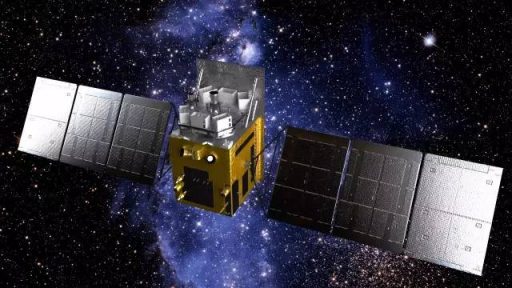
The Hard X-Ray Modulation Telescope (HXMT) is a Chinese X-Ray Space Observatory launching in 2017 as the country’s prime X-ray astronomy mission to observe black holes, neutron stars and other intense X-ray and gamma-ray sources to study the high-energy universe.
A project of several institutes in China, HXMT hosts three collimated X-ray telescopes tasked with a full scan of the Galactic Plane to find new transient X-ray sources, monitor known sources, and to observer X-ray binaries to study dynamic phenomena in intense gravitational and magnetic fields.
The 2.8-metric-ton observatory has had an extraordinarily long road to launch, first proposed in 1993 and selected for further study in 2000 to advance to the development stage with an initial plan of launching in 2010. However, these plans could not be realized and HXMT ended up requiring funding under three of China’s Five-Year Plans as the project evolved through the addition of payloads and optimization for the working conditions found in Low Earth Orbit.
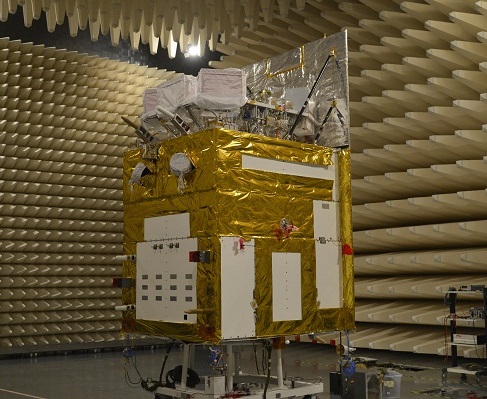
The mission’s design was eventually frozen in 2011 when approval was given for the project to enter into hardware manufacture, starting with the fully functional ground testbed before the flight unit began assembly after 2012.
Part of the HXMT Project are the Chinese Ministry of Science and Technology, the Chinese Academy of Sciences, Tsinghua University and satellite platform builder CAST. According to the HXMT Project, the Institute of High Energy Physics at CAS and Tsinghua University were responsible for the development of the Payload Module while CAST designed the satellite platform – reportedly based on heritage from the Ziyuan-2 Earth Observation Satellites which were based on high-resolution military imaging satellites and used the Phoenix-Eye-2 satellite bus.
The Ziyuan-2 satellites were among the largest and heaviest Chinese satellites when being launched between 2000 and 2004, hosting medium-resolution imaging payloads to capture Earth imagery at a 3-meter ground resolution. Ziyuan-2 entered development in 1993, the same year HXMT was first proposed, providing a connection between the platform and mission.
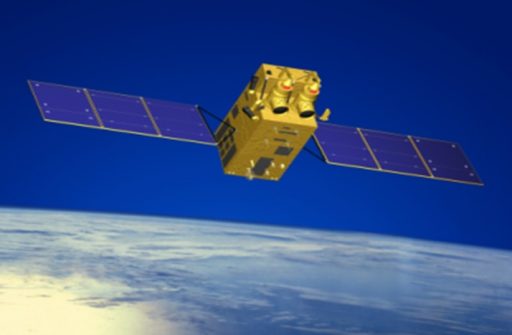
Phoenix Eye-2, optimized for operation in Low Earth Orbit, can have launch masses in excess of 2,600 Kilograms featuring two three-panel solar arrays, a three-axis attitude determination and control platform for precise pointing, and a propulsion system consisting of orbit correction engines and attitude control thrusters.
The HXMT satellite measures 2.0 by 2.0 by 2.8 meters in size and has a launch mass of 2,800 Kilograms with the payload making up more than one metric ton of the satellite’s initial mass. According to the project, HXMT provides excellent three-axis stabilization with a control precision of +/-0.1 degrees, pointing knowledge better than 0.01° and attitude stability of 0.005°/sec. The payload module is 1.9 by 1.65 by 1.0 meters in size.
HXMT carries three main payloads, all slat-collimated X-ray telescopes that cover different energy ranges to create a system that can deliver high-resolution images and spectral data over a broad energy range.
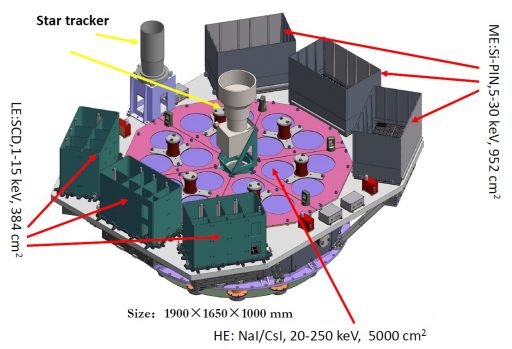
The biggest of the three is the high-energy X-ray telescope (HE) that covers an energy range of 20 to 250 kilo-electronvolt and has a large active area of 5,100cm². ME, the medium-energy X-ray telescope, covers energies of 5 to 30 keV with an active area of 952cm2, and the 384cm² low-energy X-ray telescope (LE) is sensitive for X-rays between 1 and 15keV. Additionally, HXMT hosts a CsI detector to detect gamma-ray bursts.
The typical field of view of HXMT’s aligned telescopes is 1° x 6° with additional fields of view toward other directions in order to obtain measurements of the cosmic X-ray background.
HXMT will be tasked with two different types of measurements – an all-sky survey around the Galactic Plane and focused observations on objects of interest to obtain their broad band spectra and multi-wavelength temporal properties. The sky survey is intended to discover new X-ray sources including transient objects that are of particular interest for further scrutiny.
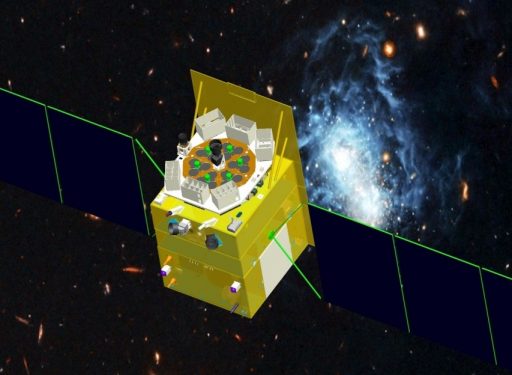
Specifically, HXMT aims to conduct measurements on various types of Active Galactic Nuclei (AGNs, supermassive black holes) to help understand the nature of the cosmic X-ray background.
The mission will also study the quasi-periodic oscillation and other time-constrained phenomena of black holes and neutron star X-ray binaries, taking advantage of the telescope’s large active area that allows for the study of short time-scale variability. Observations will also me made to examine the cyclotron resonance features and the magnetic field strength of ultra-dense neutron stars and remnants of supernova explosions will be studied for their non-thermal X-ray emission properties and mechanisms of particle acceleration.
HXMT stands out among other X-ray missions for its combination of high-angular resolution, time resolution and spectral resolution as well as its multi-use capability for all-sky scans and narrow-field pointed observations. Its method of direct demodulation to reconstruct X-ray images at high angular resolution is also a novelty in space-based X-ray astronomy.
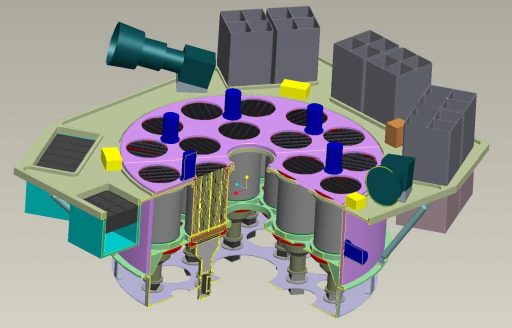
One unique aspect of the HXMT mission is the ability to rapidly target transient sources. As part of its scan of the Galactic Plane, the telescope is expected to detect a number of new transient sources as well as X-Ray binaries in their high-emission state.
A quick-look software algorithm will analyze scanning data collected every day and identify the position and flux of transient sources. When a source of interest is found, pointed observations can be put into the spacecraft’s operational plan within 24 hours of the first detection to capture valuable data.
The High-Energy X-Ray Telescope (HE) comprises 18 NaI/CsI phoswich detectors arranged in the central section of the Payload Module using two concentric circles with six elements in the inner circle and 12 elements in the outer circle.
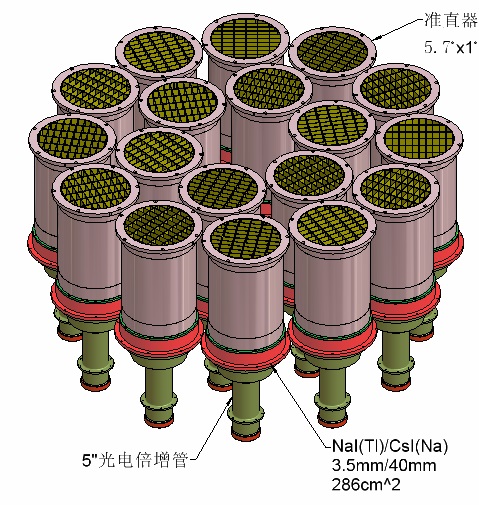
Phoswich elements, short for phosphor sandwich, employ a combination of different scintillating materials which absorb the energy of an incoming X-ray or gamma-ray photon and re-emit the energy in the form of light which can be measured using conventional photo-detectors. In a phoswich, two scintillators with different pulse shape characteristics are optically coupled and interface with a photo-multiplier. Analysis of the pulse shape is used to distinguish signals from the two scintillators to identify the scintillator in which the event occurred.
The advantage of phoswich detectors comes in the measurement of low-energy gamma- and X-rays as well as measurements in a higher-background environment.
In HXMT’s case, the scintillators are Sodium Iodide doped with Thallium and Caesium Iodide doped with Sodium. Each phoswich crystal element is 19 centimeters in diameter, the 3.5mm thick NaI crystal lies directly behind a Beryllium window and the 40mm CsI crystal is located underneath the NaI. The full energy of an incident X-ray is deposited into the NaI crystal while the CsI is used as active shielding to reject events from the back side.
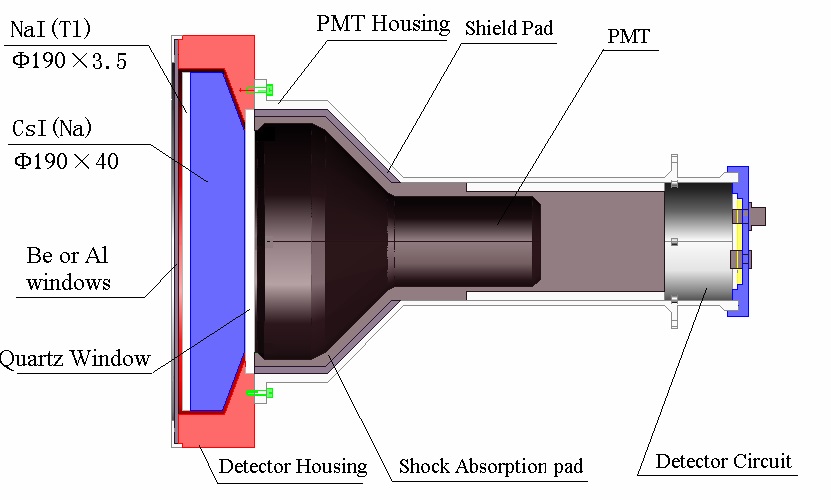
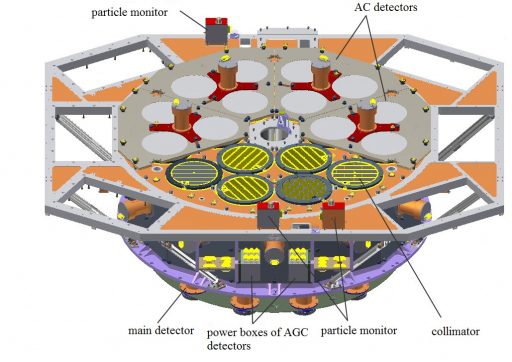
Each of the 18 HE detector elements have an active area of 283.5cm² and in front of the detectors themselves reside Tantalum & Tungsten collimators that set the field of view for each detector.
Fifteen of the detectors have a field of view of 1.14 by 5.71 degrees, two have a larger 5.71 by 5.71-degree FOV for background detection and the final element is fully blocked with a 2mm tantalum shield for dark current measurements. The overall active instrument FOV is 5.71 by 5.71 degrees. Surrounding the detector assemblies on all sides except the optical axis are scintillating plastic plates that act as veto to depress events caused by particles not arriving on the instrument’s optical axis.
Underneath the phoswich stack is a quartz separator that couples the scintillator to the Photomultiplier tube in which the visible radiation photons are converted into electrons which can produce an electrical signal that can me measured. Photomultipliers make use of the photoelectric effect, creating free electrons when photons strike the photocathode element. The electrons are directed through an electron multiplier that comprises a series of dynodes where secondary emission takes place to create sufficient electrons to produce a measurable current.
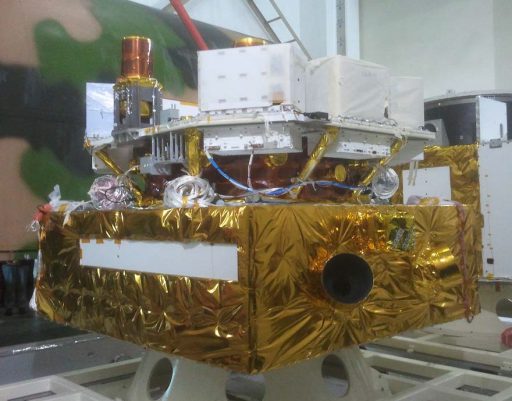
HE is capable of simultaneous spectral measurements, timing and imaging. Also, the instrument is capable of doubling as a gamma-ray detector, sensitive in an energy range of 40 to 600 keV in normal operations mode and 200 keV to 2 MeV when in GRB mode. In this mode, the instrument will be important for observations of Gamma-ray burst spectra and the search for the electro-magnetic counterpart to gravitational waves which have only recently been proven to be a real concept.
Each of the 18 high-energy X-ray telescopes has its own high-gain controller, installed in the corresponding collimator grid and adjusting the photo-detector voltage in real time to keep a stable detector gain.
Three particle monitors installed on the instrument deck are in charge of measuring the influx of high-energy protons and electrons. If charged particle flux is higher than a programmed threshold, the high voltages of the detectors will be automatically decreased to avoid damaging the photomultiplier tubes. An additional requirement for HE is a stable thermal environment, requiring the detector assemblies to be maintained at 18°C +/-1°C.
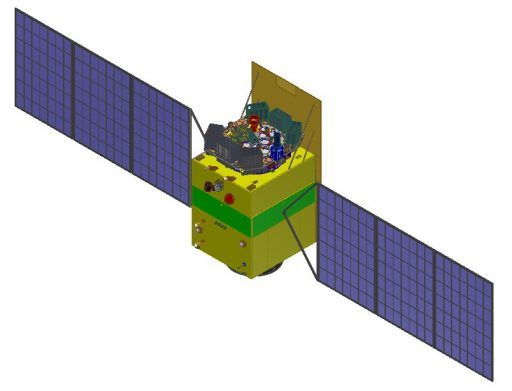
HE hosts a central electronics box that is responsible for providing the high-voltage power supply to the detectors and accept amplified signals from all detectors and anti-coincidence monitors. Data from the instrument is delivered to the satellite platform through LVDS high-speed interfaces and a 1553 data bus is used for relaying housekeeping telemetry to the satellite and accepting commands for instrument actuation. The electronics box also receives a pulse-per-second signal for time synchronization as well as a 5 MHz signal from an ultra-stable oscillator to provide the precise timing needed for X-ray measurements.
Testing of the flight model of HE showed the NaI scintillators can make measurements in an energy range of 16-350 keV when the instrument operates in normal mode while the CsI in GRB mode can detect gamma-rays at energies of 130 keV to 3 MeV. (In normal mode, NaI events are good events and in GRB mode, only CsI events are good events.) HE achieves a source location accuracy of under 1 arcmin, an angular resolution better than 5 arcmin and a time resolution better than 25µs.
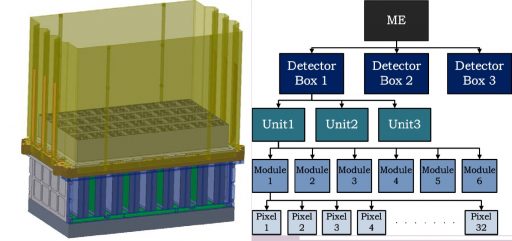
The Medium-Energy X-Ray Telescope uses a total of 1,728 Silicon-PIN diodes as detectors, facilitated in three modules installed on the optical bench of the HXMT observatory and creating a total active area of 952cm², sensitive in the 5-30 keV range.
ME also hosts three different Fields of View – the main FOV is 1 x 4° to capture data on targets, the broad FOV for background measurements is 4 x 4° and a fully blocked detector group provides dark current measurements for calibration.
The large number of PIN diodes actively gathering data requires an elaborate read out system using 54 Application Specific Integrated Circuits.
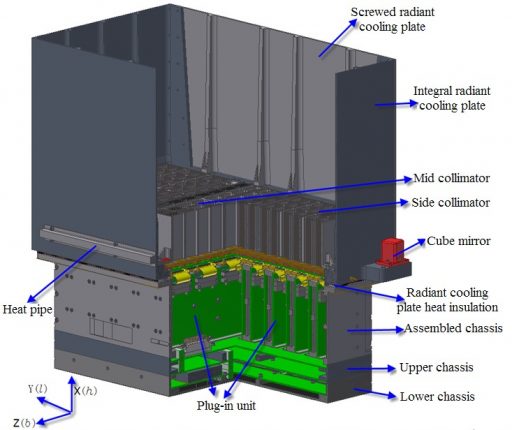
ME employs a layered architecture with the Main Electronics Box at the top, interfacing via high-speed LVDS with the three Detector Boxes containing six Modules, each reading out 32 Si-PIN pixels. Four pixels are facilitated in one ceramic package (active area of 56.25mm² each), creating a total of 432 pixel units installed on ME. The data acquisition circuit is controlled by Field Programmable Gate Arrays, allowing the acquisition to be tweaked during the mission.
The 32-channel ASIC chips form the central part of the read-out chain and are in charge of collecting raw signals from the pixels, amplifying the electrical signals, digitizing the output and transmitting the pre-processed signal to the Main Electronics Box. The use of ASIC technology allows ME to operate at a very high time resolution of 255µs.
Collimators atop each pixel set its field of view and all pixels are connected to active thermal control systems to maintain a temperature of -5 to -50 degrees Celsius to limit the effects of dark currents.

The Low-Energy X-Ray Detector (LE) is focused on sky survey and pointed observations in the soft X-ray range of 0.7 to 15 keV. It is different from the detectors on Chandra and XMM-Newton that cover a similar energy range but use grazing incidence optics. Instead, HXMT utilizes collimators to shield the photons outside the field of view.
LE comprises three detector boxes holding Swept Charge Devices that work in a continuous read-out mode, recording the energy and arrival time of incident photons to achieve a higher time resolution than traditional CCD detectors which collect photons over a pre-programmed exposure time. With its good energy and exceptional time resolution, LE is expected to make a significant contribution to X-ray astronomy.
The LE instrument hosts three identical detector boxes installed on the +Z side of the main payload section and a central electronics box within the payload module. The three boxes, similar to ME, are installed with an angle of 120 degrees to each other to enable the modulation of the signals from the three boxes to extract the image information through a restoration technique like direct demodulation.
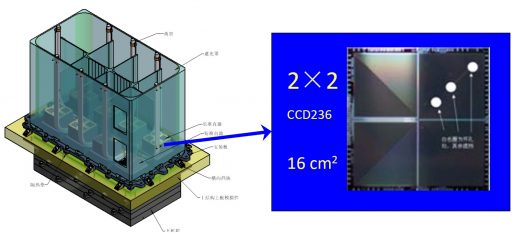
The Swept Charge Devices (SCDs) have the ability to convert the energy of an incident soft-X-ray photon into electric signals that are proportional to that photon’s energy. These electric signals are transmitted to the electronics box where they are converted to a digital representation including the event energy and arrival time. Payload data is sent to the spacecraft via LVDS and commanding / housekeeping data exchange is completed through a 1553 link.
Within each detector box are eight collimators that set the field of view for each corresponding detector unit of 2×2 pixels, making for a total of 32 SCD chips per detector box and 96 in total for an active area of 384cm². Optical blocking filters, remainder-proof films and thermal support systems like heat pipes are also facilitated within each detector box. The electronics for each box reside directly beneath it to accept the raw signals from the individual pixels for amplification, digitization and time-tagging.
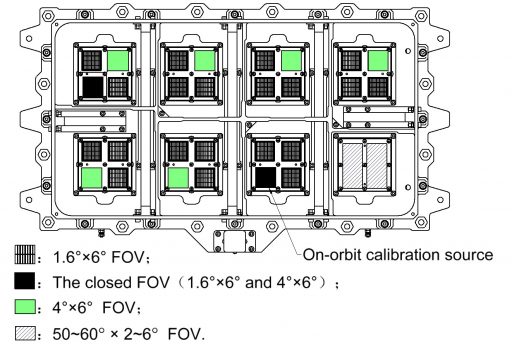
LE employs pointing observation and survey collimators with combined wide (4 x 6°) and narrow (1.6 x 6°) FOVs plus blocked pixels for background measurements and an All-Sky Monitoring collimator creates a 50~60° x 2~6° Field Of View for one pixel array per detector to support the all-sky survey that is a core objective of the HXMT mission. Of the 32 SCD pixels in each detector box, 20 have narrow FOVs, six have wide FOVs, four are All-Sky Monitor pixels and two are blocked detectors acting as calibration sources.
LE achieves an energy resolution of 140 eV and a time resolution of 1ms. Its detectors are maintained between -30 and -80°C.
HXMT will operate in an orbit of 550 Kilometers at an inclination of 43 degrees, designed for the mission’s observation objectives and to reduce the overall radiation influx to reduce backgrounds.
